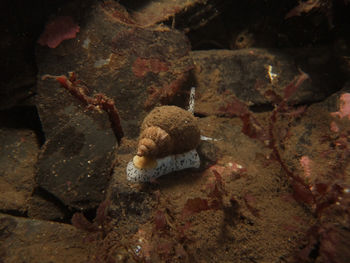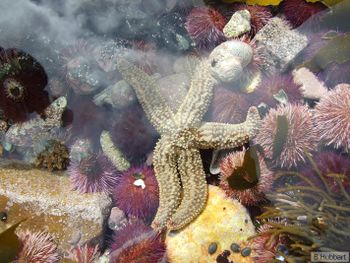| Bfn Habitat provision and support | |
|---|---|
| Context | Bfn Natural temperate rocky shores |
| Decompositie type | IOR |
Rocky shores can provide various microhabitats for both sessile and mobile organisms, such as oyster and mussel beds, macro algae turfs, and also various pits and crevices in the rocks themselves. Macroalgae communities, such as Laminaria kelp species, provide a habitat for numerous herbivores, including sea urchins and grazing snails, which in turn are predated upon by sea otters and various fish species (anon., 2006).
Additionally coastal rocks display an impressive level of diversity and abundance when it comes to sessile, filter feeding invertebrates: anemones, bryozoans, hydroids, tunicates and sponges can be found living on these coasts, in addition to hard shelled barnacles, mussels and oysters. Numerous motile invertebrate species, for example, amphipods, isopods and crabs, reside on or near rocky outcrops, because rocky shores provide shelter and food for these species, additionally so does various fish species, for instance various species of rockfish and sculpins. Furthermore, various coastal bird species, seals and sea lions use the rocks as both resting (or nesting) places and foraging grounds (anon., 2008; anon., 2010).
 |
Lynott, J. (2013). Common Whelk (Buccinum undatum) [Online image]. Retrieved March 31, 2016 from https://www.flickr.com/photos/jlynott/11636020104/ |
 |
Ito, J. (2011). Tube-dwelling anemone [Online image]. Retrieved March 31, 2016 from https://www.flickr.com/photos/joi/6086406985/ |
 |
Hubbart, B. (2008). Spiny starfish (Marthasterias glacialis) with sea urchins [Online image]. Retrieved March 24, 2016 from https://www.flickr.com/photos/36409587@N07/7214267050/ |
Habitat properties
Habitat complexity can influence the interactions of organisms living on rocky shores, for instance, abundance of sea urchins is an important limiting factor for macro algae on rocky shores as high densities of urchin population can create urchin barrens. In these barrens intensive grazing leaves the rocky substrate completely devoid of any algae besides coralline (calcifying) algae species that are more resistant to grazing activity. This extensive grazing decreases the overall biodiversity of the subtidal zone, as macro algae canopies provide a habitat for a variety of species. In complex rocky habitats sea urchins can find refuge behind rocky outcrops and crevices, while in less complex habitats they have a limited options for protection against predation and wave forces, resulting in lower spawn rates and limitation in overall population size. Therefore, while they in general have a lower macro algae density, algae growing in the subtidal area of (less structurally complex) exposed rocky shores do not need to deal with extensive grazing stress when compared to more sheltered and complex shores (Clemente and Hernández, 2008).
Predation also effects habitat differentiation of prey species, as illustrated by research done by Connel (1972), whereas limiting the size of carnivorous Thais sea snail population increased the interspecific competition between different barnacles species on two rocky shores. On the other hand, increase in predator presence thinned the barnacle population, thus decreasing their competition for space.
Subtidal substrate of rocky shores oftentimes has a large habitat heterogeneity, as a mosaic structure consisting of pits and crevices, various depressions and cracks, and planar surfaces (such as pockets of soft bottom sediment, cliff faces, smooth rock slopes), that provide various micro habitats and alter flow speeds around them (Ferrier and Carpenter, 2009). Sedimentation on rocky substrates creates relatively uniform surfaces characterized by higher water current speeds and sand scouring, thus they are an unfavorable micro habitat for organisms specialized in attachment and movement on hard substrates, for example, sea urchins and various mussel and oyster species (Clemente and Hernández, 2008; Little et al., 2010).
Refuge spaces
Barnacles, mussels, oysters and other sessile, hard shelled organisms provide rigid, heterogeneous structures that are used by various smaller organisms and larvae as refuge and surfaces for attachment. While sessile filter feeders are predominant in wave-exposed shores, on exposed shores brown macro algae cover provides shelter from predators and attachment opportunities. Red algae and kelp canopies in the lower subtidal zone provide similar functions (Little et al., 2010).
See also pits and crevices.
De View-Navigation (VN) pagina's.
De links naar andere pagina's.
| Produceert | Bfn Ornamental resources and aesthetic value, Bfn Recreation and tourism |
|---|---|
| Consumeeert | |
| Onderdeel van | Bfn Ecosystem functions of rocky shores |
| Instantie van | |
| Betreft |
Afhankelijk van.
| Afhankelijk van | Bfn Pits and crevices |
|---|---|
| Opmerkingen |
De pagina's die linken naar deze pagina.
Dit element heeft geen subelementen.
| Komt van | Type | Connectie type | Conditie | Waarde | Opmerkingen |
|---|---|---|---|---|---|
| Bfn Genetic resources and biodiversity | Refers | habitats | |||
| Bfn Rock type | Contributes | + | |||
| Bfn Surface roughness | Contributes | + |






